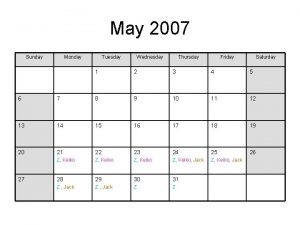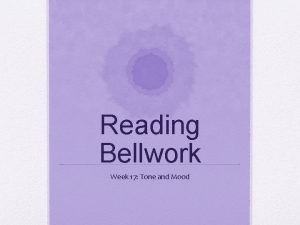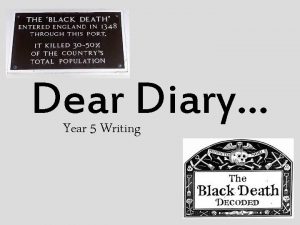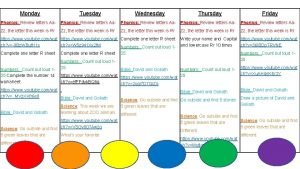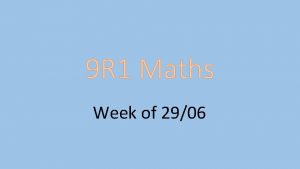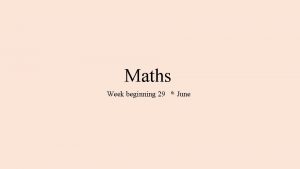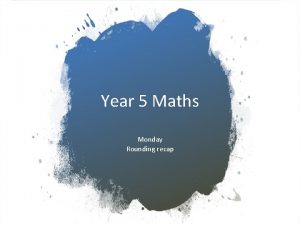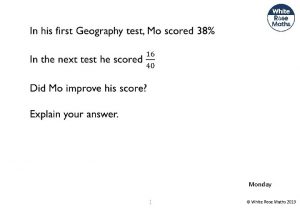9 L 2 Maths Week of 2906 Monday

















- Slides: 17

9 L 2 Maths Week of 29/06

Monday 29/06 Scatter Diagrams Continued To be able to draw and use lines of best fit

Quick 10 – no calculator Answers on next slide


Go to the link below and have a play around with the scatter diagram tool. You can see how things like wealth of different countries or population have changed over the last 100 years or choose your own data to look at. Email me any facts you found interesting or send me a screenshot. https: //www. gapminder. org/tools/#$chart-type=bubbles

Watch the video below. (you watched the first 2 minutes last lesson) Make notes on anything you didn’t already know. https: //corbettmaths. com/2012/08/10/scatter-graphs/ Continued on next slide

Complete these questions. There are templates you can use to avoid copying out the entire graph again at https: //corbettmaths. com/wp-content/uploads/2019/01/Scatter-Graphs-1. pdf

Complete these questions

Complete these questions

Extension Task (optional) Research something called the product moment correlation coefficient. This gives a correlation a number so you can compare the strength of a correlation more easily. Email me what you find out!

Answers Go to the link below and find the questions you did. https: //corbettmaths. com/wpcontent/uploads/2019/01/Scatter-Graphs-Answers. pdf

Friday 03/07 and Monday 06/07 Scatter Diagram Investigation Part 1 and 2 To find some of your own data and put it into a scatter diagram.

Use all the numbers and a mixture of plus, subtract, divide, multiply to make the number 6. A possible answer is on the next slide


Read ALL the instructions first. Over the next two lessons you are going to carry out an investigation into a topic of your choice. You are going to need to be able to collect at least 10 pieces of data. Here are some possible examples: · Number of steps taken vs length (in minutes) of walk · Number of pages in a book vs length of the author’s name · Height vs hand/paw length (if you have at least 10 people and animals in your household) · Length of movie vs star rating (imdb. com) 1. First you need to make a plan for your investigation. It needs to include: · The two variables being measured. · The equipment needed (ruler, tape measure, timer, computer, etc) · When you will do this if it can’t be done in the lesson time. · What type of correlation you think your results will show.

2. If you have any squared paper, now is the time to use it. You may need to remove a page from one of your maths books. If this isn’t possible you can google ‘squared paper’ and then print some out. Create axes (that is x-axis and y-axis) long enough to include the largest piece of data from the two variables and choose a scale wisely. As usual with graphs you need a title and labels on each axis. 3. Plot your points. 4. If possible (if there is actually a correlation) draw a line of best fit.

5. Create a poster to show your findings. You could answer the following questions: • What type of correlation can you see? • Do you think one variable causes the other? Why? • Were there any issues with your investigation? • What would you do differently if you had to carry it out again? • Are your results useful in any way? Would you be able to use your line of best fit to answer questions about the data? • Can you extrapolate (you may have to look this word up) your scatter diagram? 6. Take a photo of your poster and email it to me.
 Moday tuesday
Moday tuesday Monday is my favourite day
Monday is my favourite day Week by week plans for documenting children's development
Week by week plans for documenting children's development Happy monday welcome back
Happy monday welcome back Sunday monday a to z
Sunday monday a to z Happy monday answer
Happy monday answer Simplify √150
Simplify √150 Monday bellwork
Monday bellwork Monday
Monday On monday i (have) math and art
On monday i (have) math and art A visit to a doctor on monday текст перевод
A visit to a doctor on monday текст перевод Humanity by elma stuckey
Humanity by elma stuckey Happy monday afternoon images
Happy monday afternoon images Sing along song
Sing along song Sunday monday letters
Sunday monday letters Homework for monday
Homework for monday Happy monday november 1st
Happy monday november 1st Monday august 26
Monday august 26




